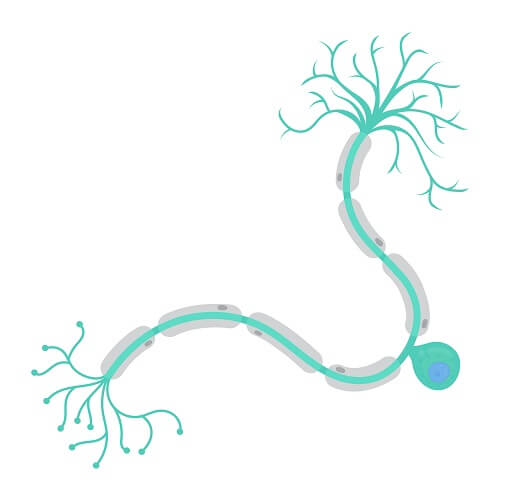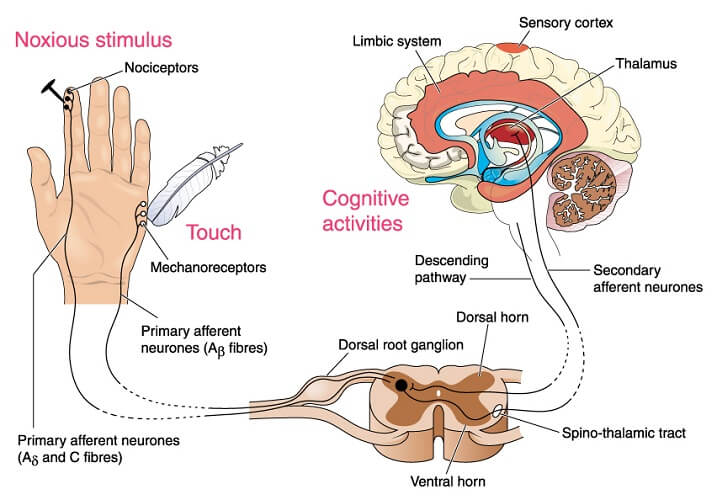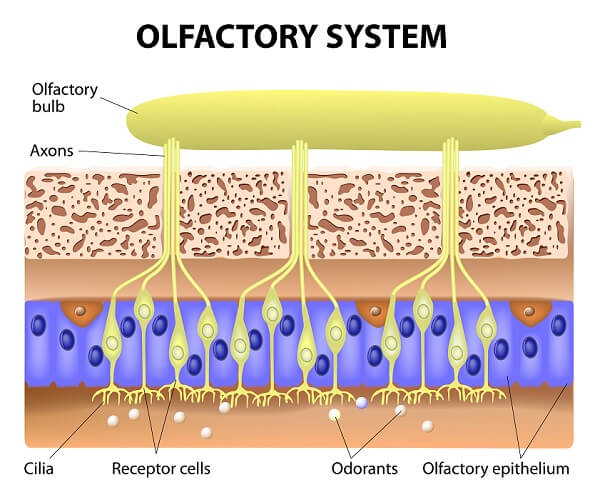Definition
A sensory neuron (sometimes referred to as an afferent neuron) is a nerve cell that detects and responds to external signals. Sensory neurons receive information via their receptors, which are part of the peripheral nervous system, and convert this information into electrical impulses. These impulses act as signals and are passed on to the central nervous system. The spinal cord and brain then receive and respond to this information.
There are various types of sensory neurons that differ in their structure, location, and stimuli to which they respond.

Overview of Neurons
Neurons are cells of the nervous system that can transmit electrical impulses to facilitate communications between the brain and the rest of the body. There are three main types of neurons: sensory neurons, relay neurons, and motor neurons.
Motor neurons control movement, sensory neurons allow us to feel sensations, and relay neurons allow motor neurons and sensory neurons to communicate with one another.
To accurately respond to stimuli, the brain relies on information communicated by sensory neurons. Sensory neurons detect inputs from the environment, convert them into signals (electrical impulses), and pass the information on to the brain and spinal cord, where a response can be generated. Different types of sensory neurons respond to different stimuli, for example, some neurons detect temperature, others detect pain, and some are specialized for taste.

Structure of Sensory Neurons
A typical neuron is comprised of dendrites, an axon, and a cell body, and the sensory neurons are no exception. Most sensory neurons are pseudounipolar, which means they have a single axon extending from the cell body that forms two extensions: the dendrites and the axon.
The sensory neuron “begins” with the dendrites, as this is where the signal is received from the external environment. The dendrites branch-like projections that receive the signal. In sensory neurons, the dendrites are generally very long.
The signal from the receptors at the end of the dendrites travels along the nerve fiber until it reaches the cell body. The cell body is the location of the nucleus, cytoplasm, and other organelles. In pseudounipolar sensory neurons, the cell body is located in a side branch of the nerve fiber.
The fiber that carries the signal away from the cell body is called the axon. In sensory neurons, the axon is short. The axon communicates with the spinal cord, and the end of the axon is where the neuron terminates.
The nerve fibers are protected, insulated, and nourished by a fatty cushion, called a myelin sheath. The myelin sheath is made of a layer of Schwann cells.
Location of Sensory Neurons
The cell bodies of sensory neurons cluster together at regions called the dorsal ganglia of the spinal cord, sometimes called the dorsal root ganglia. Note that the term ganglia simply means a collection of cell bodies.
Sensory neurons begin in the periphery. For example, in the skin, we can perceive tactile stimuli that detect touch, pain, and cold because of the sensory neurons located at the surface. The sensory neuron then carries this information to the cell body and the axon. The axon passes this information to the spinal cord, where it also terminates. The information in the spinal cord is then passed to the brain. If the sensory information stimulates a reflex action, this can be directly communicated by the spinal cord to the motor neurons. For example, the knee-jerk reflex is controlled by signals from the spinal cord.

Function of Sensory Neurons
Sensory neurons make up all the senses in the body, even those of which you are not consciously aware! The function of sensory neurons is to detect and transmit signals from a peripheral region to a more central location in the central nervous system, i.e., the spinal cord or the brain.
The transduction of the signal takes place in the sensory receptor at the dendritic end of the neuron. This is where the new signal is generated in response to a stimulus, such as a smell, touch, or taste.
The stimulus triggers the sensory neuron to send a signal then carries information towards the central nervous system. Specifically, depolarization is initiated at the sensory receptors and transmitted along the dendrites to the cell body and then to the axon. At the axon terminal, the signal initiates the release of chemicals into the synapse. These chemicals are what trigger the response in the spinal cord.
Sensory Neurons vs. Motor Neurons
To put it simply, sensory neurons are for “feeling,” and motor neurons are for “doing.”
Motor neurons are efferent (meaning they carry information out towards the periphery from the central nervous system). In contrast, sensory neurons are efferent (they carry information in towards the central nervous system from the periphery).
Motor neurons tend to have a multipolar morphology, with a single axon and many dendrites. However, sensory neurons are usually pseudounipolar. Additionally, motor neurons have short dendrites and long axons, whereas sensory neurons have long dendrites and short axons.
The two neurons also have profound functional differences. Whereas in motor neurons, the new nerve impulse is generated in the neuron of the motor cortex of the brain, in the sensory neurons, the new signal is generated in the peripheral nervous system.
Types of Sensory Neurons

Sensory neurons can be classified in various ways, including by their morphology, location, and the stimulus they are responsible for detecting. Below are some examples of sensory neurons classified by the type of stimulus to which they respond.
- Olfactory sensory neurons are bipolar neurons located in the nasal cavity. They are activated by odor molecules in the air and give us our sense of smell. A (somewhat controversial) study estimated that humans can discriminate over one trillion different odors!
- Gustatory receptors, or taste receptors, detect the chemicals found in food to give us a sense of taste.
- Photoreceptors are a special type of neuroepithelial cell that converts light into electrical signals. Thus, they communicate to the brain, allowing us to see the world around us. The two primary types of photoreceptor cells in the human eye are the rods and the cones.
- Thermoreceptors allow us to detect temperature changes in the environment. Some thermoreceptors are cold-sensitive, others are heat-sensitive.
- Mechanoreceptors detect changes in pressure or mechanical stress. For example, triggering the knee-jerk reflex occurs as a result of the activation of a motor neuron. The motor neuron is activated in response to the stimulation of a mechanoreceptor in the knee.
- Proprioceptors, also called position sensors, communicate information about the location of our body parts in relation to other body parts. These are what give us spatial awareness and coordination. It is also important for our sense of balance.
- Nociceptors are responsible for pain and temperature sensations, such as the pain you feel in your mouth after eating spicy foods.
Quiz
